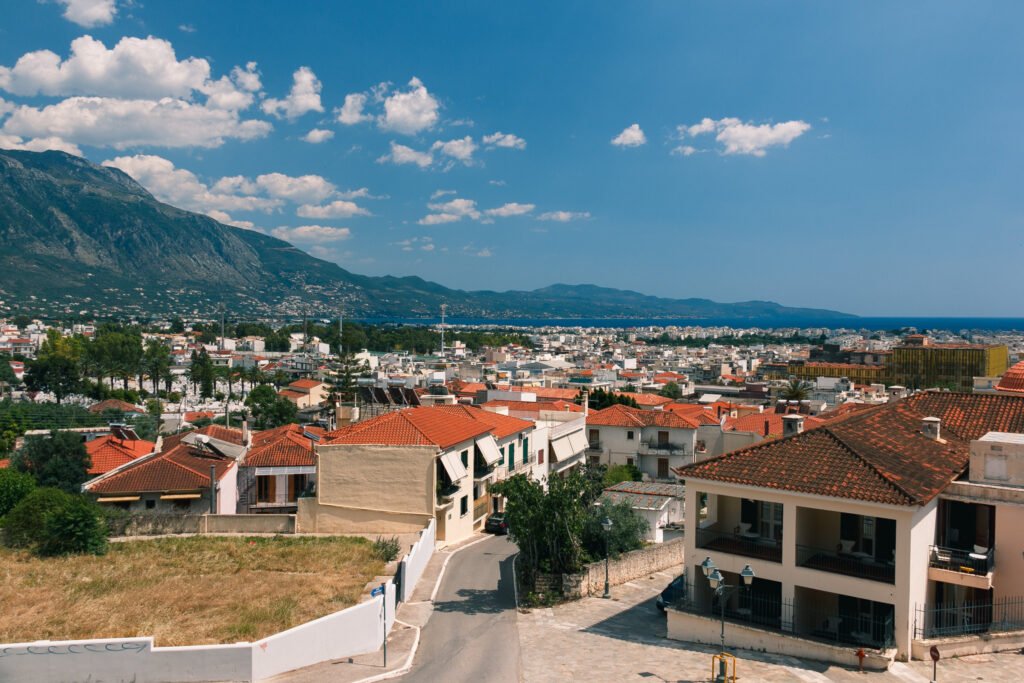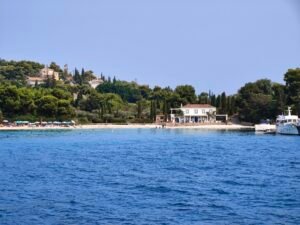Kalamata, Greece – a Must Visit Destination in the Peloponnese

Surrounded by Messinia’s natural wonders, Kalamata stands as the vibrant capital and central port of this enchanting region in Greece. The city, situated 238 km southwest of Athens, is a captivating blend of ancient history, rich cultural heritage, and breathtaking landscapes. Let’s embark on a journey through the charms of Kalamata, exploring its historical sites, cultural treasures, and nearby destinations.
Historical Marvels and Cultural Delights
Castle of Isabeau and Old City: The iconic “castle of Isabeau” stands proudly as a testament to Kalamata’s historical richness. Constructed in the 13th century, the castle offers a panoramic view of the city and hosts the renowned International Dance Festival annually. Descend to the Old City, Palia Poli, nestled at the foot of the castle, where history comes to life through landmarks like the Metropolitan Panagia Ipapanti church, the Kalograion Monastery with its silk weaving workshop, and the Byzantine church Agioi Apostoloi.
Must-See Attractions: Immerse yourself in Kalamata’s cultural tapestry by visiting key attractions, including the City Hall, Modern Greek Art Gallery, Benakeion Archaeological Museum, Vassileos Georgiou Square, Aristomenous Street, Folklore and History Museum, Municipal Theatre, and Railways Park.
Seaside Bliss: Kalamata’s extensive beach, stretching over 4 km, invites beachgoers to bask in crystal-clear waters and Blue Flag-awarded beaches. Along the seaside road, discover a plethora of tavernas, ouzo restaurants, cafeterias, bars, and clubs, creating a lively atmosphere. The western beach, connected to the city center by a cycle lane, boasts a marina and picturesque views.
Nearby Destinations
Scenic Beaches: Explore the nearby beaches at Verga, Mikri Mandineia, Avia, and Kitries, which have evolved into vibrant resorts with tourist facilities and a lively summer nightlife.
Messini: Just 11 km northwest of Kalamata, the small town of Messini beckons with the Byzantine church of Agios Dimitrios, the Municipal Mansion, and the T. Katsoulidis Museum of Carvings.
Mountain Villages: Traverse the stunning road to Kalamata from Sparta, winding through the western slope of Mt. Taygetos, and discover the charm of traditional mountain villages, making it one of the most picturesque routes in Greece.
Events and Festivals
Easter Tradition: Experience the revival of the “saitopolemos” (dart-war) custom on the eve of the Resurrection at Western Beach Kalamata, adding a unique cultural touch to your Easter celebration.
Summer Extravaganza: Revel in cultural events, theatrical performances, and concerts at the Castle amphitheatre during the summer months, while the International Dance Festival and International Documentary Festival showcase the city’s artistic spirit.
Carnival Celebrations: Join the lively Carnival events in Kalamata’s central square, featuring the traditional “gaitanaki” (maypole dance). In Messini, the major Carnival on the last Sunday culminates in the symbolic “hanging of the old lady” on Ash Monday.
Easter Horse Racing: For a dash of excitement, attend the Easter Monday horse racing events in Plati, just 16 km northwest of Kalamata.
Weather in Kalamata
Kalamata boasts a Mediterranean climate, ensuring mild, wet winters and hot, dry summers. The region experiences approximately 300 days of sunshine annually, making it an ideal destination for sun-seekers. Summers, from June to August, bring temperatures ranging from 25°C to 35°C (77°F to 95°F), offering the perfect conditions for beach outings and outdoor exploration. Winters, from December to February, are characterized by mild temperatures around 8°C to 15°C (46°F to 59°F), creating a pleasant atmosphere for cultural excursions and sightseeing.
Best Time to Visit
For those seeking a harmonious blend of favorable weather and cultural festivities, the best time to visit Kalamata is during the spring and early autumn. From April to June and September to October, temperatures hover between 18°C to 28°C (64°F to 82°F), providing a comfortable environment for exploration without the intense summer heat. Additionally, these seasons coincide with vibrant local events, ensuring a lively and enriching experience.
How to Get There
By Air: The most convenient way to reach Kalamata is by flying into Kalamata International Airport (KLX). The airport operates seasonal flights and offers connections to major European cities. From the airport, it’s a short 9 km journey to the city center, easily accessible by taxi or rental car.
By Car: If you prefer a scenic road trip, Kalamata is well-connected by road networks. From Athens, embark on a picturesque drive of approximately 238 km southwest. The journey showcases the diverse landscapes of Greece, from mountainous terrains to coastal vistas.
By Bus: Intercity buses provide an affordable and comfortable option for travelers. Buses operate regularly from Athens to Kalamata, offering a relaxing journey through the Peloponnese region.
By Train: While train services in Greece are limited, you can take a train to nearby cities like Tripoli or Patras and then continue your journey to Kalamata by bus or car.
Whichever mode of transportation you choose, the journey to Kalamata is a prelude to the enchanting experiences awaiting you in this captivating Greek destination. Embrace the warmth of the Mediterranean sun and the rich cultural tapestry that defines Kalamata, creating memories that will linger long after your visit.






